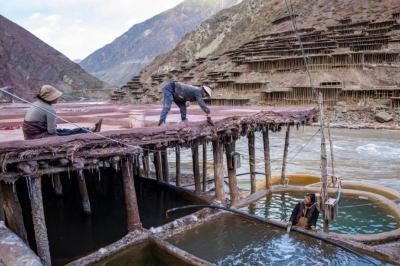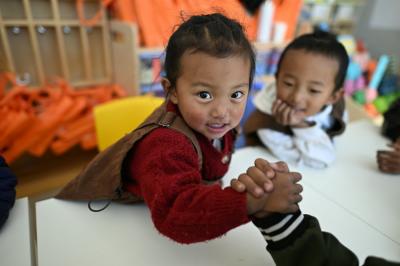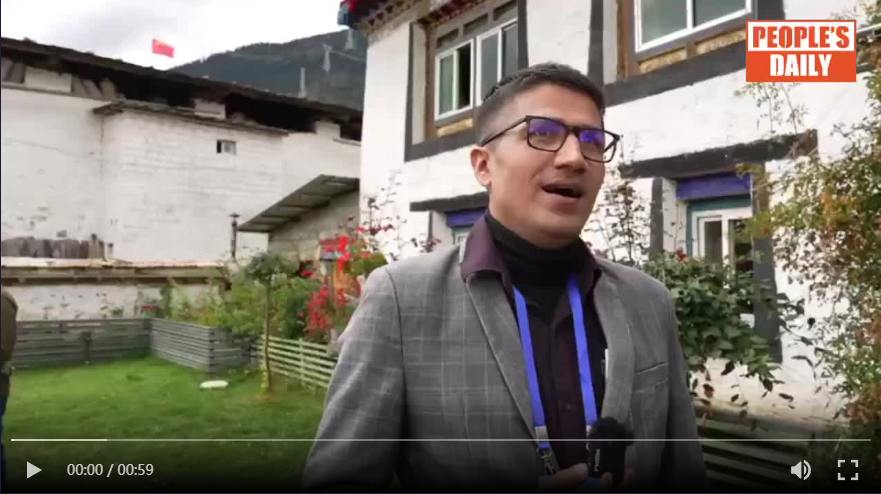| Nov. 21, 2017 -- Editor's note: The Sichuan-Tibet Plateau, a beautiful region that reaches toward the heavens, is a place showered with blue skies, covered in white clouds, and dotted with snow-covered mountains, but recently, something truly remarkable has been materializing among the households that call this place home. A groundbreaking historic change has been reshaping the land and its people. From today on, we will publish a series of stories to tell you those changes. Garze's Dege County lies near the southeastern flank of the Qinghai-Tibet Plateau. The average altitude here is 4,235 meters (13,894 feet) above sea level, and this place is the center of Dege-Khangpa culture of ethnic Tibetan, with people referring to it as the "origin of Khangpa culture" and the "hometown of King Gesar". The town of Ezhi, situated in the northwestern portion of the county, is the highest location of Sichuan Province, bordering Serxu County, which itself is the northwestern tip of the province. The town is around 210 kilometers (130 miles) away from the county seat, and it covers an area of 470.5 square kilometers (181.7 square miles). The altitude here on average is above 4,000 meters (13,123 feet), and some villages can even be found at 4,500 meters (14,764 feet). The amount of oxygen here is 60% less than that of further inland, and the natural conditions are substandard. All six administrative villages have been listed as impoverished, and over 2,000 people live in them. The population's income relied heavily on digging up caterpillar fungus, and per capita, they received less than 2,500 yuan (377 US dollars) annually. Although their land seems charming, smiles from the people used to be really hard to come by. For those 21 cadre members dispatched by Chengdu's Xindu District, the changes seen in both Dege County and the town of Ezhi are really the results of their two years of hard work, and Ezhi most certainly seems to be on its way to realizing complete poverty relief. In 2016, Yanda Village successfully became the first to shed its status of being "poor", and today, the elementary school there has been completely renovated, with the local health center now fully equipped to take on most medical needs. Senior citizens live in comfortable houses that have been built specifically for them, and the people are actually happy with their lives on the plateau, seemingly basking under its magnificent sunlight. Keeping Children in School 13-year-old Droma loves school, but she had to drop out after the fifth grade to take care of her four siblings. Her father, a farmer, went to Chengdu years ago but knew how important an education was in life. He tried to get her to go back to school, but Droma refused. She believed that as she was the eldest in her family, it was her duty to look after her siblings while her parents stayed away from home year after year. Her decision was final. Droma is no longer a little girl with two cute pigtails, but one year ago, with the support and promotion of a specialized cadre dispatched from top-level government offices to support Tibetan-inhabited areas, she was able to return to the newly established Ezhi Elementary School. "The school is completely different than it is used to be! It's all changed for the better! Teachers, equipment, facilities, everything has improved!" Droma has a beautiful goal: after elementary school, go to middle school, high school and, finally, college in the inland. "Ever since I was little, my dad told me that Chengdu was beautiful, especially with all the beautiful lights at night. Maybe one day I can go there to see them, too!" She pictures what the sight in Chengdu might be like, and smiles at her mind's vision as if she was there now, taking it all in and basking in its glow. Children are the future of these Tibetan-inhabited areas, and education is the key to end poverty there. For two years, now, the Xindu District support team has adhered to a "Look ahead, but watch where you tread!" mentality, focusing on education, medical service, industrial development, and other poverty relief efforts. The team has active access to over 900 thousand yuan (135,747 US dollars) in funds, with over 200 thousand yuan (30,166 US dollars) worth of materials from various sources. One after another, a total of seven elementary and middle schools with 751 poor local students were directly affected by this charitable aid. The Chinese version of this story is written by Chen Xiaozhong and translated into English by Huang Wenjuan. And the story is sourced from the United Front Work Deparment of the Communist Party of China (CPC)Sichuan Provincial Committee. Editor: Ana Wu |
- Home
- News Tibet |Exclusive |China |World |Related News |Latest
- Documents White Papers |Others
- Photo Politics |Economy & Society |Culture & Religion |Human & Nature |Beautiful Tibet |Other Tibetan-Inhabited Area |Exchanges |Related
- Video News |Documentary |Micro-Video |Entertainment
- Art
- Tourism
- In Focus
- About Tibet






